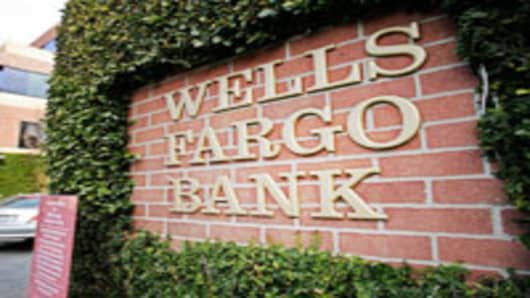Wells Fargo's acquisition of Wachovia late last year helped the bank generate a surprisingly healthy $3 billion in earnings for the first quarter, Wells Fargo CFO Howard Atkins told CNBC.
Wells Fargo, the fourth-biggest US bank, stunned investors Thursday by announcing it expected the record results. The news sent the bank's stock soaring and pushed the entire stock market higher.
In a live interview, Atkins said the bank released the results two weeks early because it felt the the news was important to the market.
"In December we closed the Wachovia acquisition," said Atkins. "This is the first quarter the two companies have been combined and because of the move, we thought it was important to get this news out early."
Atkins said that the losses in the acquistion are behind Wells Fargo. "We did write off most of them [losses]and we are enjoying the benefits of the merged companies," said Atkins.
Atkins said details on Wachovia savings are "going to begin to emerge in the second quarter."
- Related Story: Berkshire Hathaway Shares Leap on Wells Fargo Earnings
The San Francisco-based bank, which has received billions of dollars in government funds, said it expects to earn 55 cents a share for the quarter ended March 31. Analysts polled by Thomson Reuters, on average, forecast earnings of 23 cents per share.
It expects net chargeoffs of $3.3 billion in the quarter, down from about $6.1 billion in the fourth quarter for Wells Fargo and Wachovia combined, and will add $1.3 billion to loss reserves.
Analysts agreed that the Wachovia acquisition, which came after the bank was forced to seek a merger partner during the market meltdown last fall, was a boon for Wells Fargo.
"This was the deal that made them," said banking industry consultant Ken Thomas of Wells Fargo's acquisition of Wachovia, citing its strong franchise value and small businesses lending operation. "It was a very good decision by Wells Fargo. Wachovia could not have survive on its own. They had a run on deposits."
Housing, FASB and TARP
Atkins said that housing situation was still very slow but improving. "We are not out of the woods yet," said Atkins. "But there are good signs in the housing market.
Wells Fargo said it made more than $100 billion of mortgage loans in the quarter, and has an application backlog of $100 billion. The bank said it makes one in seven U.S. mortgages.
Atkins went on to say there was "very little impact" on results from a new rule by the Financial Accounting Standards Board that gives banks more freedom to value assets as they would in normal markets rather than at distressed prices.
He also said Wells Fargo would like to repay the bailout funds received under the Troubled Asset Relief Program "as soon as practical." "The government will decide ultimately when that can be done. The main point is that our objective is to earn profit, as we did in the first quarter so successfully," he said.
When asked if the earnings report might spur an equity offering by Wells Fargo, Atkins said that growing good earnings was the best path for the bank. "That's the best way to grow capital," said Atkins. "The best way is to keep earnings growing."
It was unclear whether the figures are comparable with those of a year ago, after the bank issued $25 billion in preferred shares to the U.S. government. It also could not immediately be determined whether the $3 billion was before or after dividends paid to the U.S.
Treasury.
A year ago, the bank reported first-quarter profit of $2 billion. The bank is due to report full first-quarter results on April 22.
"Our business momentum is strong and we expect our operating margins to remain at the top of our peer group," Chief Executive Officer John Stumpf said in a statement.
The San Francisco bank slashed its dividend 85 percent in March, which it said would save it $5 billion a year.
The bank also said last month it was planning $2 billion in additional cost cuts this year, starting in the second quarter. Wells Fargo bought Wachovia for about $12.5 billion on Dec. 31. The bank has said it expects $5 billion in annual cost savings from the acquisition.
Charge-offs are expected to total $3.3 billion for the first quarter, compared with a combined $6.1 billion between Wells Fargo and Wachovia during the fourth quarter.
Analysts welcomed the better-than-expected results.
"It confirms some expectations that the banks were doing better with their charge-offs," said Nick Kalivas, equity market analyst at MF Global Research, Chicago. "Some lower-rated assets are rallying and the relaxing of the mark-to-market rule is also helping. This public-private plan is helping with the marking up of assets. No one expects them to be this good. It's possibly a good indicator for the market."
Art Cashin, director of floor operations for UBS, said the market's response could be a good sign.
"[M]aybe we're beginning to turn the corner in the financials," he told CNBC. "Maybe things are getting better. Maybe some of the various government programs added some stability."
Still, Cashin remained cautious about the market outlook. "I tend to think we might have a little bit of a false spring here," he said. "I'm going to remain a little bit skeptical on this particular leg of the move."'
Others were also skeptical that Wells Fargo had turned the corner.
"I don't think that this is an all-clear for Wells Fargo because they have a considerable portfolio of loans on their books that are somewhat concerning," said Michael Farr, president of Farr, Miller and Washington. "They have got a huge portfolio of home equity loans."
—Reuters and AP contributed to this report.



